Tested: 1979 Chevrolet LUV vs. 1979 Toyota 4wd
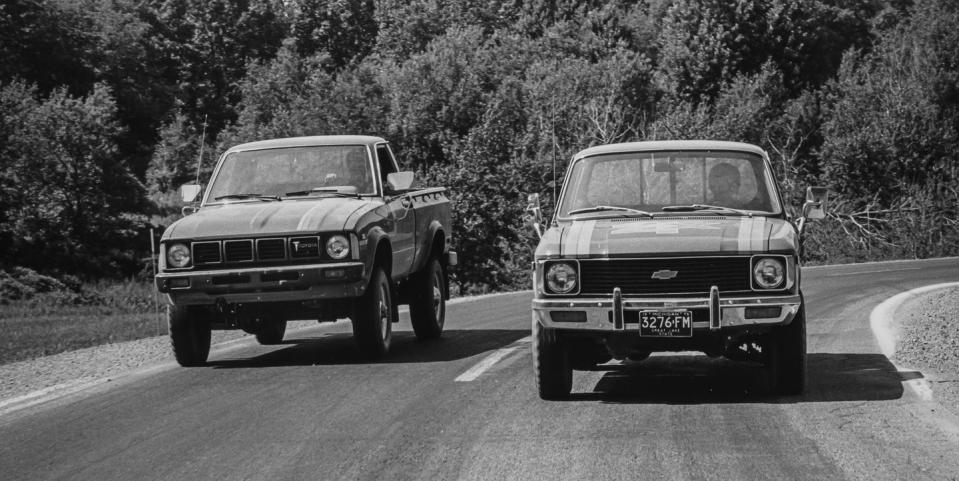
From the November 1979 issue of Car and Driver.
Soft, powdery Chrysler-proving grounds dirt is coming in the window. A choking pea-soup fog churned up by four madly spinning tires engulfs Toyota's LUV 4wd pickup as I wrestle it, bucking and howling, toward the rim of the Soup Bowl.
The Soup Bowl is part of Chrysler's off-road-vehicle testing facility, a ravine that gouges ten stories deep into the overgrown Chelsea, Michigan, landscape. There are about a half-dozen trails out of the bowl, some as steep as 45 percent. From the top, you feel as though you were standing in the upper deck of Yankee Stadium. The people at the bottom look very small.
Chrysler has generously allowed us access to its off-road preserve so that we might get better acquainted with the first two efficiency-era off-road trucks: the Toyota 4wd and Chevrolet LUV four-by-four mini-pickups. It never even occurs to us that this will also be an opportunity to roar, slide, bounce, wiggle, and thump through the Michigan countryside unmolested by the authorities. Not for a second.
One obvious fact marks these two Japanese-built pick-'em-ups as the first of tomorrow's four-by-fours: they're far more fuel-efficient than their much larger domestic counterparts. A LUV, for instance, will travel 20 EPA city miles on every gallon, about 25 percent farther than a comparably equipped full-grown Chevy pickup. The government, to no one's surprise, has duly noted the fuelishness of Blazer-class rigs and will slowly legislate them out of existence with new 4wd fuel-mileage standards that start in 1980. And interest in the big rigs has already faded significantly, ever since OPEC first dialed back the flow of crude. If you have any doubt that mini-trucks are the answer, just try to find a dealer that has any in stock.
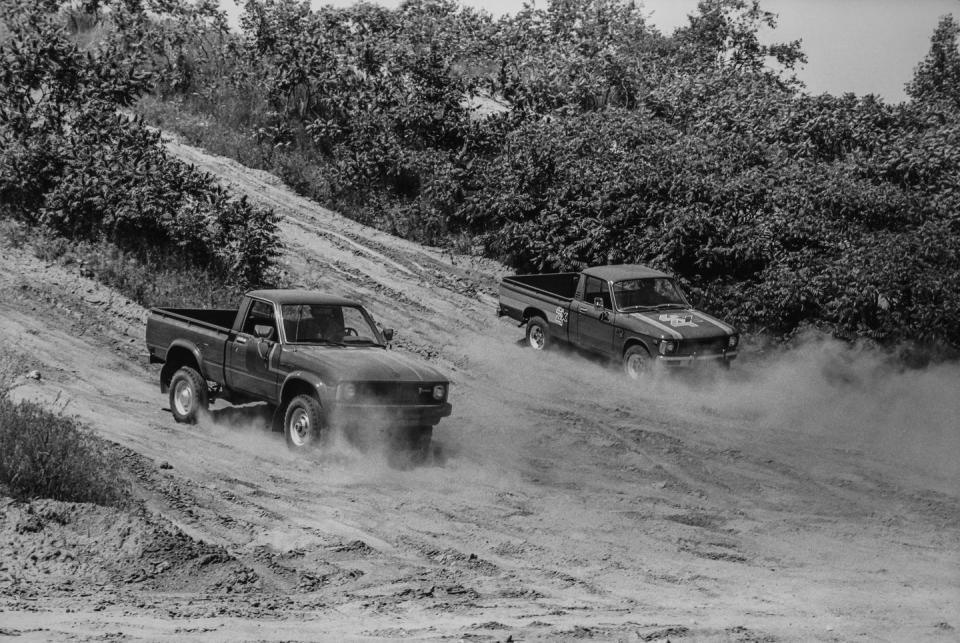
It's been that way ever since Subaru pioneered the tiny 4wd vehicle back in 1978 with its BRAT and 4wd wagon. But those were gentlemen off-road machines, transformed sedans intended for light-duty use. The LUV and the Toyota, on the other hand, are trucks, built with all the heavy-duty functionalism that that term implies.
Both of these trucks have been with us a while. Isuzu sent the LUV over from Japan at the beginning of 1979, and Toyota had its all-wheel-driver on the market in mid-year. If a 4wd pickup seemed like a good idea way back when fuel was flowing relatively freely, it's positively inspired now.
Still, there's more to their attractiveness than good fuel economy. Like their 2wd siblings, these 4wd trucks are lighter and more compact than the domestic pickups. The LUV, at 2780 pounds and 173.8 inches in length, is at least a half-ton lighter and a foot and a half shorter than Chevy's home-grown pickups. Numbers like these make the LUV and the Toyota more nimble, more maneuverable, and easier to park than the chunky full-sized brands.

We have only one self-imposed restriction during the testing: we will not jump the trucks under any circumstances, because we have learned the hard way that production four-by-fours will twist themselves into scrap iron when you make like Evel Knievel.
The first event is Free-Form Driving Around, wherein we charge up and down every one of the Soup Bowl's trails. The trucks throw up blinding clouds of dust that settle on every interior surface and pack dirt into our every pore. Hell, there's even dirt in my teeth. But we do not jump the trucks.
Event number two is the first head-to-head clash, a sophisticated off-road test thought up by technical trendsetter Don Sherman. It's called Let's Race Up That Hill. Time and again we attack the slopes, with front hubs locked, transfer cases in low range, and gear levers in first. Door handle to door handle, we scrabble up the steep, soft grades, the trucks bucking and jumping and throwing rooster tails of dirt—sometimes into the cabs. Now and again the trucks get hung up and slither sideways toward each other. We even race up the hills backwards in our search for a winner—but mostly just for the fun of it. And it is fun, rollicking good fun, punctuated with howling tires and howls of laughter. Amazingly enough, only once is there body contact, and it's light.
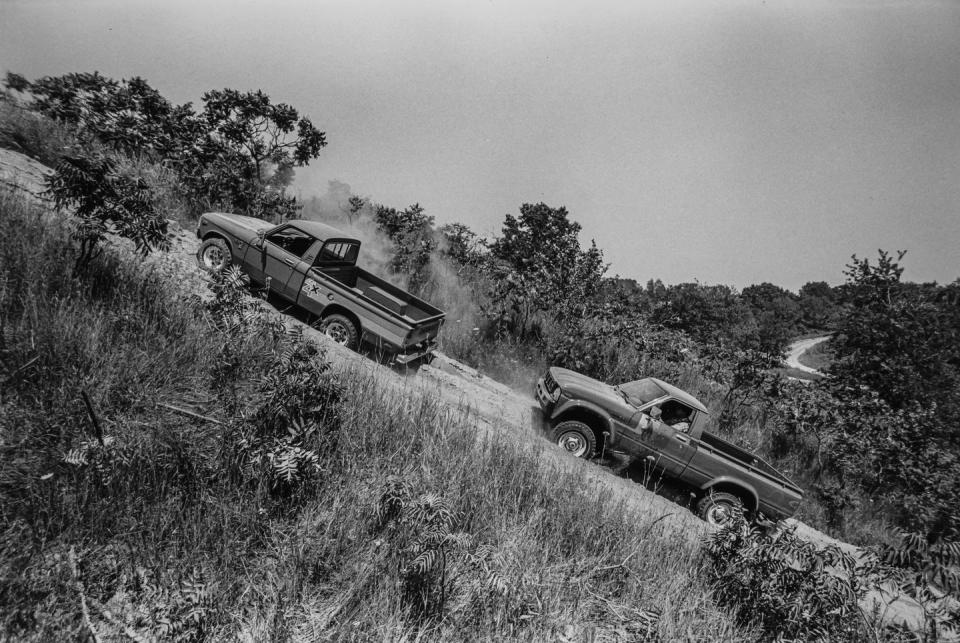
The first confrontation is judged a draw. Both trucks seem to have equal helpings of traction and climbing prowess, though the Toyota does exhibit the more colorful climbing style: the fuel system, for some mysterious reason, starves intermittently, causing the engine to surge on and off at full throttle, and the chassis jackhammers whenever the tires lose their grip. The LUV, by comparison, is much more sedate—but no more adept.
Four-wheel-drive trucks, of course, are expected to do much more than just climb out of ravines. So to deepen our understanding of these two mini-mites, a change of venue is called for. Chrysler, you may know, builds tanks for the government—and they have to test them somewhere, right? The "somewhere" turns out to be a perfect site for a trail-riding comparison.
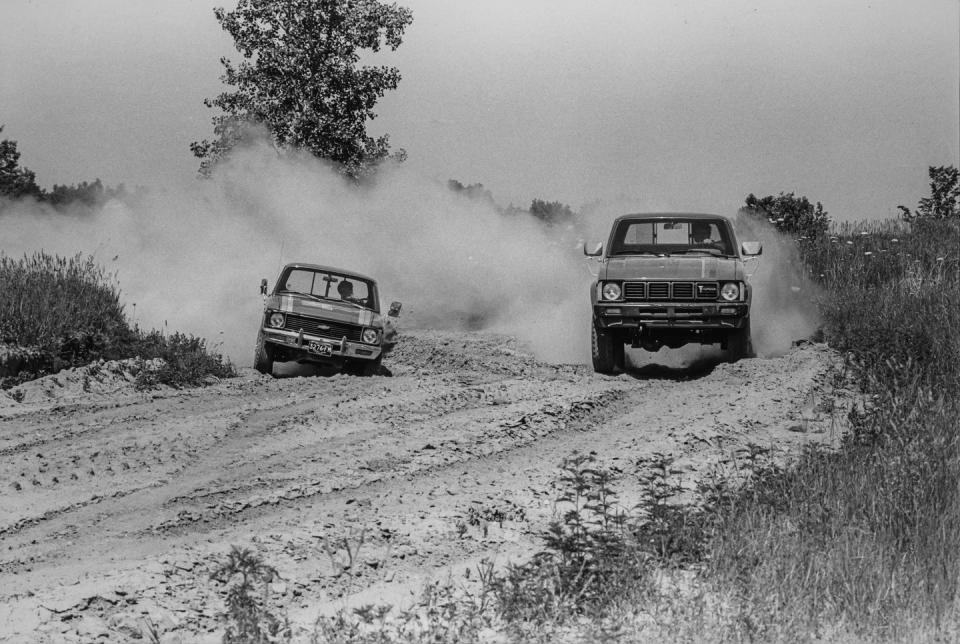
The tank-testing course is a twenty foot-wide, serpentine swath cut from the undergrowth, twisting and turning in a mile-long loop. The surface ranges from ankle-deep sand to hard-packed dirt. The loop is bounded by trees, shoulder-high banks, and ditches, while the center of the trail—the part that passes under a tank's belly—rises high enough to form a natural divider between the outer and inner lanes in some places. It's high enough to flip a truck.
The able Mr. Sherman again hits on an excellent test procedure. "Let's race," he suggests. And race we do, in 2wd this time—it's easier to hang the tail out in the corners—on what could easily pass for a special stage in a pro rally. We bounce, wallow, tilt, slide, and buck furiously around the course, whipping the dust into a smoke screen; at times I can't so much as see the end of my hood.
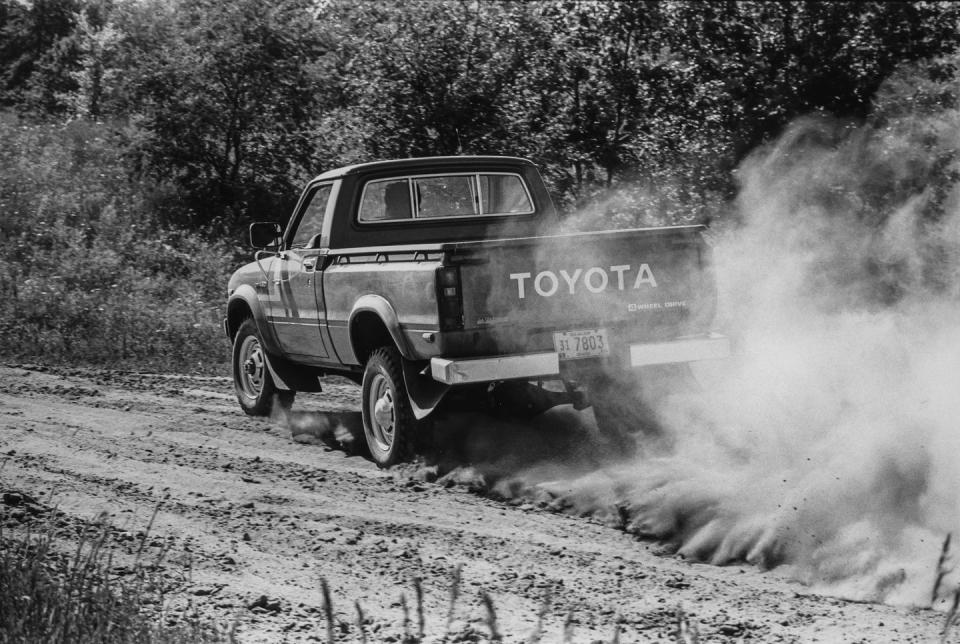
The Toyota's lighter and quicker power steering makes feverish steering corrections easier, but its added height and resulting tippiness—it's five inches taller than the LUV—make it more intimidating to drive hard. The power difference between the two doesn't even come into play. The result is another dead heat.
The afternoon's foray in, around, and through the wilds of Chelsea has led us to the surprising conclusion that, in the brush, neither truck is more capable or more fun than the other. Their relative equality is especially curious considering the differences in their designs and specifications. The Toyota went in as the overdog, and one look will tell you why: it's as macho as the Duke was, standing tall enough to look a Blazer right in the eye. (We later discovered that it actually offers 1.5 inches less ground clearance than the LUV.) The Toyota's 2.2-liter four has fifteen more horsepower and 27 more pound-feet of torque than the LUV's 1.8-liter engine. And the Toyota sports 15-inch mud-and-snow tires as opposed to the LUV's 14-inchers. Nevertheless, the trucks' tractive abilities and general offroad manners were as close as you'II ever find in two competing makes. Both were a ball to bash around in, and both stood up to our rambunctious romping without so much as a trace of fatigue. We hereby pronounce them fit for enthusiast use, and every bit as rugged as the Essex-class rigs of yore.
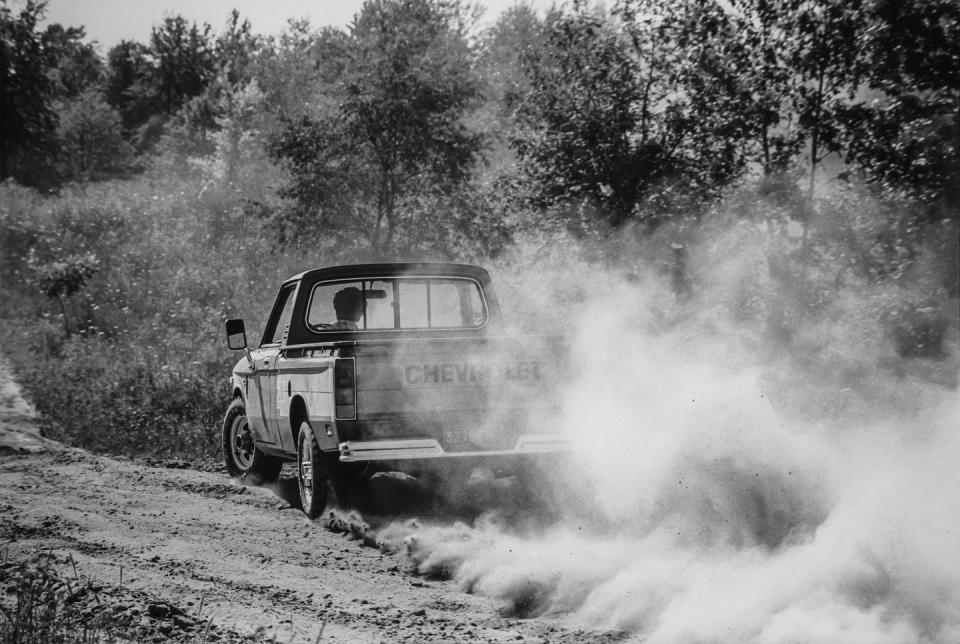
All of this fun in the woods, however, makes it all too easy to forget that there's a flip side to this story. Most off-road vehicles spend the vast majority of their time on the road. And that's just why we devoted but a single day to our off-road extravaganza. We lived with the trucks on the street for weeks.
Unfortunately, neither of these trucks takes very well to the civilized life. In fact, few vehicles have spent more nights in the company parking lot than these two. If annoying traits were worth money, these two would cost a fortune: they accelerate as though loaded with a ton of bricks, they make your ears ring on the highway, and, worst of all, they have no affinity whatsoever for paved surfaces. They show their contempt for hard corners by lurching unnervingly and lifting their inside rear wheels in the fire-hydrant salute. And they both ride, well, like trucks, though the Toyota is by far the bigger pain in the butt—literally. Our test Toyota acted as if it had concrete for springs and wrought iron for shocks, bucking and jerking over every crack, wave, and bump in the road. It was otherwise easy to maneuver, nicely trimmed, and more than roomy enough, but the feeling that we were inside a giant Shake 'n Bake bag took all the fun out of it. To be fair, Toyota tells us the long-bed, 110-inch wheelbase version rides better. But none was available for comparison, so we really can't speak to the validity of that claim.
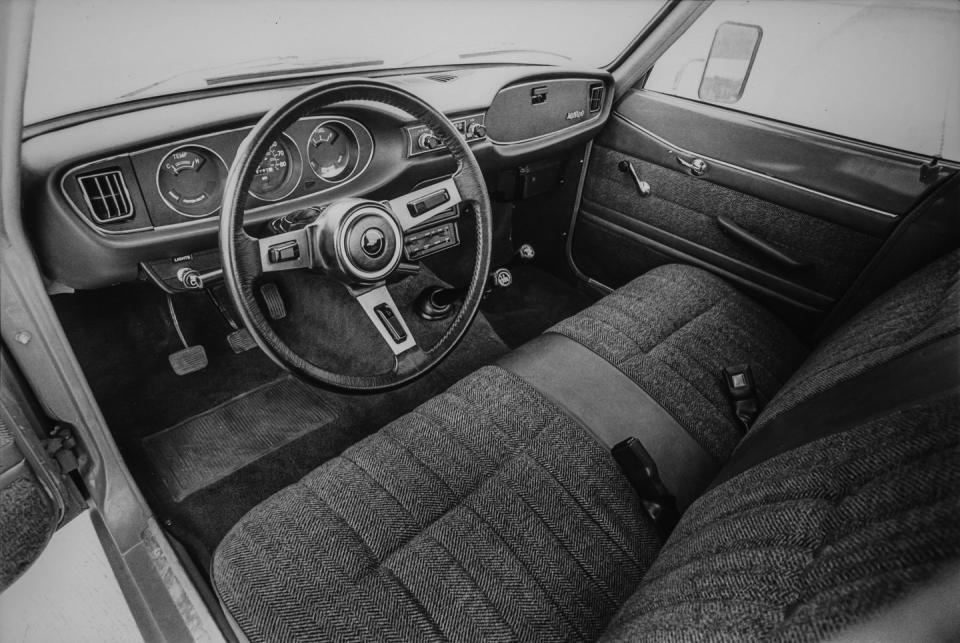
The LUV, by comparison, had a more sophisticated way of dealing with the paved terrain. Its independent front suspension did a much better job than the Toyota's solid-axle-leaf-spring arrangement. But we still can't think of a sedan that's as rough-riding as the LUV. And while the LUV doesn't have any glaring faults, it does suffer because of the cumulative effect of a few smaller problems: the steering is heavy and slow, the engine is positively anemic, and the cab is cramped for six-footers.
About the only thing these two do well on the street is hauling. Then they're just wonderful. Both trucks' payload capacities—the combined weight of passengers and cargo—are in the 1100-pound range. That's a few hundred pounds less than larger four-by-fours can carry, but unless you make a habit of hauling around bridge abutments, it ought to suffice.
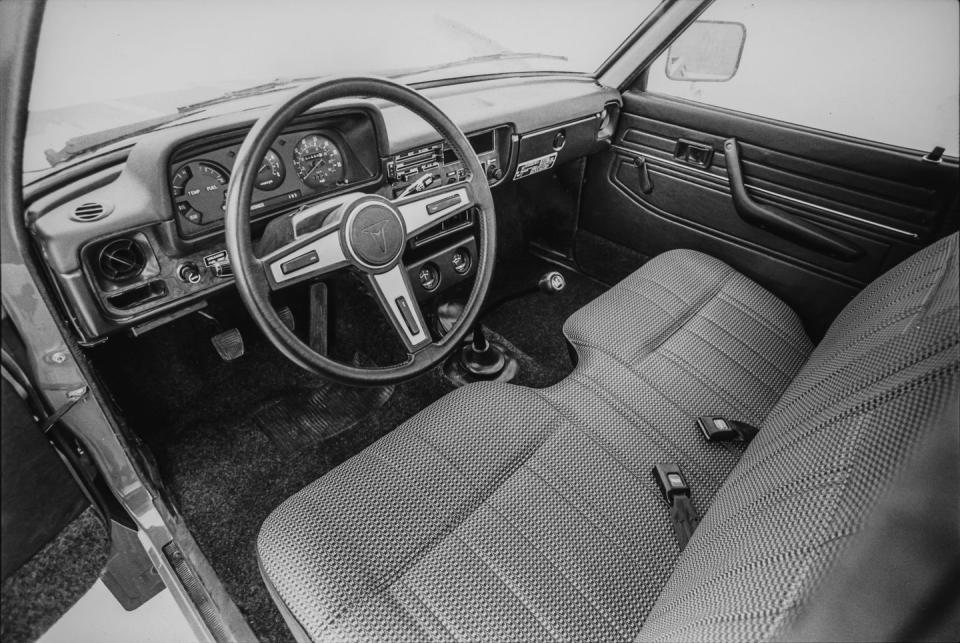
The "Michigan stopper" is what tractor pullers call a transfer: 43,000 pounds of movable weight that can be gradually applied to a skid that claws into the good earth. Properly adjusted, a transfer can develop enough resistance to stop a 2000-hp competition pulling tractor in its tracks. The stopper belongs to the Michigan Tractor Pullers, Inc., an association that promotes tractor-pulling events in the Midwest. They've agreed to help us with this final event, a head-to-head test of sheer pulling strength that's about as subtle as arm-wrestling. Oh, sure, we know hooking a 4wd mini-pickup to a tractor-pull transfer sounds crazy. That's because it is crazy.
It takes quite a bit of figuring and testing and adjusting for the Pullers to lower the transfer's resistance enough so that our mini-mites can budge it. That done, the trucks grunt out a couple of runs each. Power talks, and theToyota chugs its way to the 56-foot mark before stalling out, exhausted. The LUV can manage only an agonizingly slow 30-foot pull.
Then someone jumps a truck. During a jaunt around the Saline Community Fairgrounds, one of the Michigan Pullers runs the Toyota off the end of a loading dock or something. He returns with the front axle pretzeled, but the truck is still drivable. Oh well, we tried to be good.
The new generation of 4wd pickups has proved itself as able as the old guard in most respects. The Toyota and LUV four-by-fours are trucks through and through: rugged, a blast in the out-back, terrific for hauling gear, and lousy car substitutes.
So there's no need to worry about the future of four-wheeling in an energy-conscious world. The first of the new economical breed are here, and they are good. We confidently predict that tomorrow's off-road rider will find his trails happy and his trucks fit.
You Might Also Like

 Yahoo Autos
Yahoo Autos